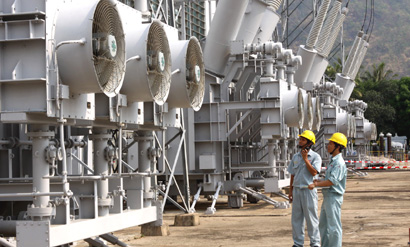 |
| Engineers inspect a transformer in Da Nhim Hydroelectric Plant in the Central Highland province of Lam Dong. Drastic measures are being taken to ensure electricity supply in this year's dry season. |
The order was issued amidst increasing concerns over electricity shortages which are the consequence of a long-lasting drought and the tardy progress of new power projects.
Deputy Minister of Industry and Trade Do Huu Hao said that with the economy recovering, demand for power in the first quarter of the year rose by 20.2 per cent year-on-year.
"It was an abnormal surge, proving that we have not used electricity efficiently and economically," Hao said.
The Ministry's Electricity Regulatory Authority (ERA) which initially forecast a 15 per cent increase in demand for the whole year has raised its forecast to 17 per cent and total demand for power this year to 99.2 billion kWh instead of 97.5 billion kWh.
According to the ministry, water levels in reservoirs are now at an unprecedented low.
Late last week, the water level in the Tuyen Quang Hydropower Plant – the second largest of its kind in the north – had declined to an alarming level, only six metres higher than the minimum level required to maintain the plant's operation. Currently only one of its three turbines is operational.
It is likely that the ministry's target of having 14 new power plants in operation adding 3,335MW to the national grid will not be met because most of the construction projects are running behind schedule.
The 220MW Son Dong thermal plant in Bac Giang Province was expected to become operational in the first quarter of this year, but only one of its two turbines is running, while the third 120MW turbine of Se San 4 hydropower plant remains unfinished.
"In the first quarter, 450MW could not be added to the national grid as many of the power plant construction projects had failed to meet their deadlines. This will cause a severe electricity shortage during the dry season this year," the ERA said.
"Another drawback is that some new plants like Quang Ninh I, Cam Pha and Uong Bi have continuously suffered breakdowns leading to down time for repairs."
In Dung's latest instruction, the Ministry of Industry and Trade was ordered to ask Electricity of Viet Nam (EVN) and other related agencies to regularly review the power-supply situation; balancing the north, south and central region's grid systems' ability to provide power; and assess consumption and regional hydrometeorology in order to develop optimal solutions to electricity supply shortages.
The ministry was also requested to supervise and speed up the progress of power plants so that they would come into operation as scheduled.
EVN has to take responsibility for co-operating with authorities under the Ministry of Agriculture and Rural Development in efficiently using water resources for power and agricultural production.
The agency must closely work with the National Centre for Hydro-meteorological Forecasting to update forecasts of weather and water resources to economise water usage.
The Prime Minister also required the Viet Nam National Oil and Gas Group to ensure technical conditions so that gas provision equipment and machineries would not be put into maintenance and gas provision would be adequate for power production, especially in the dry season this year.
Deputy Minister Hao said that the ministry had asked investors and the EVN to reassess when the power plants would go on stream so as to formulate plans for the dry season.
To ensure enough power, EVN was ordered to generate electricity using diesel or gas despite the high costs involved, Hao added.